Italian war crimes
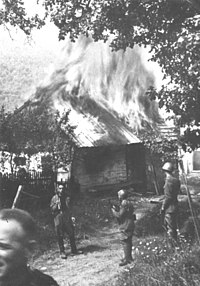
Italian war crimes have mainly been associated with
Italo-Turkish War
In 1911, Italy
Pacification of Libya
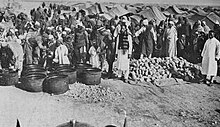
In 1923,
Second Italo-Ethiopian War
During the
According to the Ethiopian government, 382,800 civilian deaths were directly attributable to the Italian invasion. 17,800 women and children were killed by bombing, 30,000 people were killed in the massacre of February 1937, 35,000 people died in concentration camps, and 300,000 people died of privations due to the destruction of their villages and farms. The Ethiopian government also claimed that the Italians destroyed 2,000 churches and 525,000 houses, while confiscating or slaughtering 6 million cattle, 7 million sheep and goats, and 1.7 million horses, mules, and camels, leading to the latter deaths.[8]
During the 1936–1941 Italian occupation, atrocities also occurred; in the February 1937
.Spanish Civil War
75,000 Italian soldiers of the Corpo Truppe Volontarie fought on the side of the Nationalists during the Spanish Civil War, as did 7,000 men of the Aviazione Legionaria. While they also bombed valid military targets such as the railway infrastructure of Xativa, the Italian air force partook in many bombings of civilian targets for the purposes of "weakening the morale of the Reds". One of the more notable bombings was the Bombing of Barcelona, in which 1,300 civilians were killed, with thousands more being wounded or dehoused.[9] Other cities subjected to terror bombing by the Italians included Durango, Alicante, Granollers, and Guernica.
Documents found in British archives by the historian
World War II
The
A number of suspects, known to be on the list of Italian war criminals that
Yugoslavia

In April 1941, Italy invaded Yugoslavia, occupying large portions of Slovenia, Croatia, Bosnia, Montenegro, Serbia and Macedonia, while directly annexing to Italy the
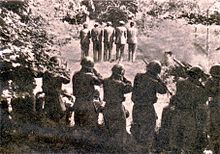
In May 1942 Mussolini told
Italian concentration camps
Mass killings of civilians and hostages
In retaliation for Partisan actions during the Uprising in Montenegro, Italian forces, under the command of General Alessandro Pirzio Biroli, killed 74 Montenegrin civilians and captured Partisans in Pljevlja on 2 December 1941.[25] Italian forces committed further massacres on 14 December 1941, in the villages of Babina Vlaka, Jabuka and Mihailovici, destroying homes and killing 120 Montenegrin civilians.[26]
In early July 1942, Italian troops operating opposite Fiume were reported to have shot and killed 800 Croat and Slovene civilians and burned down 20 houses near Split on the Dalmatian coast.[27] On 12 July 1942, Italian forces killed around 100 Croat civilians in the Podhum massacre, and deported another 889 civilians to concentration camps.[28] Later that month, the Italian Air Force was reported to have practically destroyed four Yugoslav villages near Prozor, killing hundreds of civilians in revenge for a local guerrilla attack that resulted in the death of two high-ranking officers.[29] In the second week of August 1942, Italian troops were reported to have burned down six Croatian villages and shot dead more than 200 civilians in retaliation for guerrilla attacks.[30] In September 1942, the Italian Army was reported to have destroyed 100 villages in Slovenia and killed 7,000 villagers in reprisal for local guerrilla attacks.[31]
On 16 November 1942, after a Partisan attack on a military truck convoy, Italian forces launched a combined and indiscriminate land, air and naval bombardment targeting the small Croatian town of Primošten in reprisal. Some 150 civilians were killed in the attack, nearby villages were also burned and 200 citizens were arrested.[32]
Throughout January 1943, Italian forces belonging to the "Lombardia" and "Re" divisions, launched large anti-Partisan operations in the Lika region, around Gospić. During the operation, Italian forces razed 12 villages, destroying or burning around 2,806 homes and farms and killing 635 civilians.[33]
During anti-Partisan operations in July 1943, Italian forces razed the village Žrnovnica and 23 surrounding hamlets. During these reprisals, Italian forces burned down about 900 houses, shot 97 civilians, interned 880 civilians and destroyed about 150 boats.[34]
Italian authorities enacted a quota for civilian hostages to be shot in retaliation for Italian soldiers and citizens killed by Partisan attacks. In Dalmatia, five civilian hostages were to be executed for every Italian civilian killed and twenty civilian hostages were to be executed for every Italian officer or civil servant killed. Hostages were taken from the civilian population and were interned in concentration camps.[35]
In other areas, the quota was more arbitrary. For example, Italian forces ordered the execution of 66 civilian hostages from Šibenik on 22 May 1943, in retaliation for 22 telegraph poles sabotaged by Partisans, a quota of three hostages for each telegraph pole damaged.[36]
In Montenegro, the hostage quota was higher; in January 1942, the Governor of Montenegro ordered 50 civilian hostages to be executed for every Italian officer killed or wounded, and 10 civilian hostages to be executed for every Italian NCO and regular soldier killed or wounded.[37]
Between 24 April and 24 June 1942, Italian forces executed more than 1,000 hostages from across the Province of Ljubljana.[38] In the Šibenik district, 240 hostages were executed between 23 April and 15 June 1942,[37] a further 470 civilians were killed in reprisals at the same time across other areas of Dalmatia.[39] In late-June 1943, the Governor of Montenegro ordered the execution of 180 hostages from the Bar concentration camp.[40]
On 11 October 1941, governor
The Tribunal held four trials characterized by a hasty procedure without any guarantee for the accused, imposing forty-eight death sentences, of which thirty-five were executed, as well as thirty-seven prison sentences of different lengths.A decree given by Mussolini on 24 October 1941, replaced the Extraordinary Tribunal with the Special Court for Dalmatia, which took over the tribunal's functionality and had wide jurisdiction. Like the Extraordinary Tribunal, the Special Court worked quickly, informally and arbitrarily. According to statistics from the Yugoslav State Commission of Crimes of the Occupier and Their Assistants, a total of 5,000 people became subject to proceedings in these Italian courts and the courts condemned 500 of them to death. The remainder were given punishments ranging from long prison sentences, being assigned to forced labour or being sent to concentration camps.[45]
According to statistics collected through 1946 by the Commission for War Damages on the Territory of the
In 2012, a Slovenian census determined that the Italian occupiers were responsible for the deaths of 6,400 Slovene civilians.[47]
Other repressive anti-Partisan measures
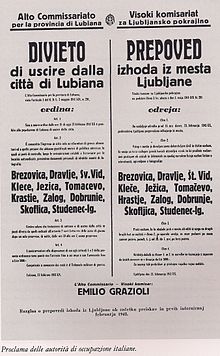
On their own, or with their Nazi allies, the occupying Italian army undertook many armed actions, including brutal offensives intended to wipe out Partisan resistance. This included Case White in Bosnia, in which German, Italian and allied quisling forces killed 12,000 Partisans, plus 3,370 civilians, while sending 1,722 civilians to concentration camps. During the Case Black offensive, German, Italian and allied troops killed 7,000 Partisans (two-thirds of the total 22,000 Partisan force were killed or wounded), and executed 2,537 civilians.
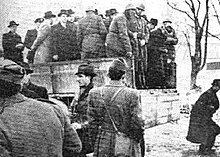
In Ljubljana Province, in July 1941, the Italian army assembled 80,000 well-armed troops to attack 2,500-3,000 poorly armed Partisans,[48] who had liberated large portions of the Province. Italian general Mario Robotti issued commands for all persons caught with arms or false identification papers to be shot on the spot, while most other men of military age were to be sent to concentration camps.[49] All buildings from which shots were fired on Italian troops, or in which ammunition was found, or the owners showed hospitality to Partisans, were to be destroyed. Italian troops were ordered to burn crops, kill livestock and burn villages which supported Partisans.[49] To destroy the resistance, the Italian occupiers also completely surrounded the capital city of Ljubljana with barbed wire, bunkers and control points. Civilians, particularly families of partisans and their supporters, were sent by the tens of thousands to Italian concentration camps, and in a meeting in Gorizia in July 1942, between Italian generals and Mussolini, they agreed to forcefully deport all 330,000 inhabitants of Ljubljana Province, if necessary, and replace them with Italians.[48]
None of the Italians responsible for the many war crimes against Yugoslavs - including Generals Roatta and Robotti, Fascist Commissar Emilio Grazioli, etc - were ever brought to trial.
Destruction of cultural heritage
In 1942 Italian fascist troops completely destroyed the remains of medieval Cathedral of Saint Bartholomew in Knin, in order to build themselves their barracks and concrete bunkers.[50][51]
Greece
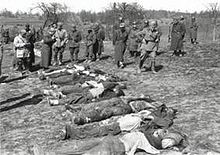
A similar phenomenon took place in Greece in the immediate postwar years. The Italian occupation of Greece was often brutal, resulting in reprisals such as the
After two Italian filmmakers were jailed in the 1950s for depicting the
Albania
Italy
From 1940, growing Albanian resistance to Italian rule led to an increase in repressive and punitive measures against the Albanian population.[62] From 14–18 July 1943, the Italian army conducted a large anti-Partisan operation in villages surrounding the town of Mallakastër, destroying 80 Albanian villages and killing hundreds of civilians.[63] According to the Statistics of the Albanian National Institute of Resistance, the Italian occupiers were responsible for 28,000 dead, 12,600 wounded, 43,000 interned in concentration camps, 61,000 homes burned, 850 villages destroyed.[64]
The Holocaust
Libya
After the passing of the anti-Semitic
In 1942, 2,600 Jews were sent by Italian authorities to the Giado concentration camp, where they remained until they were liberated by British forces in January 1943.[67] 564 prisoners died from typhus and other privations.[68]
The Soviet Union
In at least one recorded case, Italian forces taking part in the invasion of the Soviet Union, handed over a captured group of Jews to be killed by a German Einsatzkommando unit.[69]
Italy
The oppression of Italian Jews began in 1938 with the enactment of
In November 1943, the Fascist authorities of the RSI declared Italian Jews to be of "enemy nationality" during the
Approximately half of all Jews arrested during the Holocaust in Italy were arrested in 1944 by the Italian police.[73]
Of the estimated 44,500 Jews living in Italy before September 1943, 7,680 were murdered during
List of Italian war criminals
This is a working list of Italian high-ranking military personnel or other officials involved in acts of war. It includes also such personnel of lower rank that were accused of grave breaches of the laws of war. Inclusion of a person does not imply that the person was qualified as a war criminal by a court of justice. As noted in the relevant section, very few cases have been brought to court due to diplomatic activities of, notably, the government of the United Kingdom and subsequent general abolition.
The criterion for inclusion in the list is the existence of reliable documented sources.
- yperite, phosgene, and fire munitions in the form of aerial bombs and artillery and mortar shells.[citation needed]
- Pietro Badoglio: In 1936, during the Second Italo-Ethiopian War, Badoglio approved, as commander in chief of the Italian army, the use of poisonous gas against enemy troops.[citation needed]
- Vincenzo Magliocco: During the Second Italo-Ethiopian War, Magliocco was one of the generals primarily responsible for carrying out orders to use chemical weapons. He was killed in action in 1936.[75]
- Pacification of Libya and authorized the mass killing of Ethiopians known as Yekatit 12. [citation needed]
- Pietro Maletti: During the Italian occupation of Ethiopia, Between May 18 and May 22, 1937, Italian and Libyan troops under the command of Maletti massacred between 1700 and 2100 people at the Debre Libanos Monastery, including all 297 monks and 23 lay people who served the monastery, and the many pilgrims who had come to celebrate the patron saint of the monastery. Maletti was killed in action in 1940.
- Pacification of Libya. Ardent proponent of the use of poison gas and concentration camps, which resulted in the deaths of tens of thousands of civilians. Responsible for mass death sentences against resistance fighters. In 1944, De Bono was executed after being convicted at the Verona trial.[76]
- Alessandro Pirzio Biroli: The Governor of the Italian governorate of Montenegro. He ordered that fifty Montenegrin civilians be executed for every Italian killed, and ten be executed for every Italian wounded. Biroli never stood trial and died in 1962.
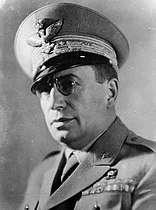
- Italian concentration camps on the island of Rab, in Gonars, Monigo (Treviso), Renicci d'Anghiari, Chiesanuova and elsewhere. The survivors received no compensation from the Italian state after the war. He had, as the commander of the 2nd Italian Army in Province of Ljubljana, ordered besides internments also summary executions, hostage-taking, and burning of houses and villages,[78][79] for which after the war the Yugoslav government sought unsuccessfully to have him extradited for war crimes. He was quoted as saying "Non dente per dente, ma testa per dente" ("Not a tooth for a tooth but a head for a tooth"), while Robotti was quoted as saying "Non si ammazza abbastanza!" ("There are not enough killings") in 1942.[80] "On 1 March 1942, he (Roatta) circulated a pamphlet entitled '3C' among his commanders that spelled out military reform and draconian measures to intimidate the Slav populations into silence by means of summary executions, hostage-taking, reprisals, internments and the burning of houses and villages. By his reckoning, military necessity knew no choice, and law required only lip service. Roatta's merciless suppression of partisan insurgency was not mitigated by his having saved the lives of both Serbs and Jews from the persecution of Italy's allies Germany and Croatia. Under his watch, the 2nd Army's record of violence against the Yugoslav population easily matched the Germans. Tantamount to a declaration of war on civilians, Roatta's '3C' pamphlet involved him in war crimes."[79] One of Roatta's soldiers wrote home on July 1, 1942: "We have destroyed everything from top to bottom without sparing the innocent. We kill entire families every night, beating them to death or shooting them."[81] As noted by the Minister of Foreign Affairs in Mussolini government, Galeazzo Ciano, when describing a meeting with the secretary general of the Fascist party who wanted Italian army to kill all Slovenes:
(...) I took the liberty of saying they (the Slovenes) totalled one million. It doesn't matter – he replied firmly – we should model ourselves upon ascari (auxiliary Eritrean troops infamous for their cruelty) and wipe them out".[82]
- Mario Robotti: Commander of the Italian 11th Division in Slovenia and Croatia, issued an order in line with a directive received from Mussolini in June 1942: "I would not be opposed to all (sic) Slovenes being imprisoned and replaced by Italians. In other words, we should take steps to ensure that political and ethnic frontiers coincide.",[83] which qualifies as ethnic cleansing policy.
- Nicola Bellomo was an Italian general who was tried and found guilty for killing a British prisoner of war and wounding another in 1941. He was one of the few Italians to be executed for war crimes by the Allies, and the only one executed by the British military.
- Italo Simonitti, a captain in the 4th Monterosa Alpine division, was executed for his involvement in the 1945 execution of an American prisoner. He was the only Italian war criminal to be executed by the U.S. military. Simonitti's subordinate, Benedetto Pilon, received a life sentence. He was later transferred to Italian custody, but freed under an amnesty by Minister of Justice Attilio Piccioni in January 1951.[84]
- Pietro Caruso was chief of the Fascist police in Rome while it was occupied by the Germans. He helped organize the Ardeatine massacre in March 1944. After Rome was liberated by the Allies he was tried that September and subsequently executed by the co-belligerent Italian government.
- Guido Buffarini Guidi was the Minister of the Interior for the Italian Social Republic; shortly after the end of the war in Europe he was found guilty of war crimes and executed by the co-belligerent government.
- Pietro Koch was head of the Banda Koch, a special task force of the Corpo di Polizia Repubblicana dedicated to hunting down partisans and rounding up deportees. His ruthless extremism was cause for concern even to his fellow fascists, who had him arrested in October 1944. When he came into Allied captivity he was convicted of war crimes and executed.
A number of names of Italians can be found in the
See also
- Italian Fascism
- Italian Fascism and racism
- Anti-Italianism
- Axis war crimes in Italy
- The Holocaust in Italy
- Internment of Italian Americans
- Italian Civil War
- List of war crimes
- Allied war crimes during World War II
- British war crimes
- German war crimes
- Japanese war crimes
- Soviet war crimes
- United States war crimes
References
- ISBN 978-0-618-35367-5.
- ISBN 978-0-521-53854-1.
- ISBN 978-1-4384-2893-2.
- JSTOR 4141408
- ^ Rainer Baudendistel, Between bombs and good intentions: the Red Cross and the Italo-Ethiopian War, 1935-1936, Berghahn Books, 2006, p.239; 131-2. Google books link
- ^ League of Nations
- ^ "Dum-Dum Bullets for Abyssinia". Courier-Mail. 14 April 1936.
- ISBN 978-0-304-93201-6. Pages 292-293.
- ISBN 978-0-14-101161-5. OCLC 53806663.
- ^ JSTOR 4141408
- ^ Conti, Davide (2011). "Criminali di guerra Italiani". Odradek Edizioni. Retrieved 2012-10-14.
- ^ a b c d Italy's bloody secret (Archived by WebCite®), written by Rory Carroll, Education, The Guardian, June 2001
- ISBN 88-04-55129-1
- ISBN 978-88-8325-135-1
- ^ General Roatta's War against the Partisans in Yugoslavia: 1942, IngentaConnect
- ^ Rodogno 2003, p. 337.
- ^ Steinberg 2002, p. 34.
- ISBN 978-0-8047-7924-1.
- ^ Dizdar, Zdravko (2005). "Italian Policies Toward Croatians In Occupied Territories During The Second World War". Hrvatski institut za povijest. p. 207.
- ^ Report on Italian War Crimes against Yugoslavia and its people 1946, p. 73.
- ISBN 978-88-339-1432-9.
- ^ "Talijanski fašistički logor Kampor - Udruga antifašista Rab". www.ua-rab.hr. Retrieved 2020-07-18.
- ^ Cresciani, Gianfranco (2004) Clash of civilisations, Italian Historical Society Journal, Vol.12, No.2, p.7
- ^ "Održana komemoracija na Spomen groblju Kampor". Retrieved 2 July 2023.
- ^ G. Scotti - L. Viazzi, L'inutile vittoria: la tragica esperienza delle truppe italiane in Montenegro, Milano, Mursia, 1998, p. 20
- ^ Davide Conti, L'occupazione italiana dei Balcani. Crimini di guerra e mito della «brava gente» (1940-1943), Odradek, Roma 2008, pp. 129-130
- ^ Report Italians Execute 800 in Yugoslavia
- ^ Tomasevich 2002, p. 134.
- ^ Italians Level Slav Villages In Reprisal
- ^ ITALIANS BURN 6 CROAT TOWNS
- ^ Italians Raze 100 Sloven Villages
- ^ Tomasevich 2002, pp. 134–135.
- ^ Report on Italian War Crimes against Yugoslavia and its people 1946, pp. 142–143.
- ^ "Ubili su milijun ljudi, a prema Hrvatima su bili posebno nečovječni. Mučili su ih, slali u logore, palili sela... Srhoj podsjeća na sve te strahote: 'Mnogi se još nisu odrekli'". 8 October 2022. Retrieved 8 January 2023.
- ^ Dizdar, Zdravko (2005). "Italian Policies Toward Croatians In Occupied Territories During The Second World War". Hrvatski institut za povijest. p. 193.
- ^ Dizdar, Zdravko (2005). "Italian Policies Toward Croatians In Occupied Territories During The Second World War". Hrvatski institut za povijest. p. 194.
- ^ a b Report on Italian War Crimes against Yugoslavia and its people 1946, p. 57.
- ^ Report on Italian War Crimes against Yugoslavia and its people 1946, p. 41.
- ISBN 978-1-4875-2636-8.
- ^ Report on Italian War Crimes against Yugoslavia and its people 1946, p. 60.
- ^ "znaci.net" (PDF). znaci.net. Retrieved 2021-09-11.
- Hrčak.
- ^ Oddone Talpo, Dalmazia. Una cronaca per la storia (1941), p. 711
- ^ "Crimini di guerra". Criminidiguerra.it. Retrieved 2021-09-11.
- ^ Dizdar, Zdravko (2005). "Italian Policies Toward Croatians In Occupied Territories During The Second World War". Hrvatski institut za povijest. pp. 190–191.
- ^ Dizdar, Zdravko (2005). "Italian Policies Toward Croatians In Occupied Territories During The Second World War". Hrvatski institut za povijest. pp. 205–206.
- ^ "Prvi pravi popis - v vojnem in povojnem nasilju je umrlo 6,5 % Slovencev :: Prvi interaktivni multimedijski portal, MMC RTV Slovenija". Rtvslo.si. 2011-01-13. Retrieved 2014-06-18.
- ^ a b Tomasevich 2002, p. 106
- ^ a b Tomasevich 2002, p. 105
- ^ Jadrijević, Ante (1967-04-14). "Smrt hrvatskih kraljeva Miroslava i Zvonimira (2). Ekskurs I — Starohrvatska katedrala na Kapitulu kod Knina, Ekskurs II — Starohrvatska županija Polje kod Knina". Crkva u svijetu.
- ^ "Globus - Kako sam otkrio katedralu hrvatskih kraljeva u Kninu". www.jutarnji.hr (in Croatian). 2013-10-22. Retrieved 2023-12-16.
- ^ P. Fonzi, "Liquidare e dimenticare il passato": i rapporti italo – greci tra il 1943 e il 1948, in "Italia Contemporanea", 266 (2012), pp. 7–42
- ^ Constantine A. Doxiadis, "Destruction of Towns and Villages in Greece." Series of Publications of the Ministry of Reconstruction, no.11 (Athens: Ministry of Reconstruction, 1947), p.59. The 112 GRD/USD conversion can be worked out from p.63.
- ^ Doxiadis, Sacrifices of Greece, Claims and Reparations, no.19, p.75-77
- ISBN 978-0-521-67408-9.
- ^ Margherita, Marchione. "Pope Pius XII: Architect for Peace." Paulist Pr, May 2000. Page 280.
- ^ Alessandra Kersevan 2008: (Editor) Foibe – Revisionismo di stato e amnesie della repubblica. Kappa Vu. Udine.
- ^ Survivors of war camp lament Italy's amnesia, 2003, International Herald Tribune
- ^ Di Sante, Costantino (2005) Italiani senza onore: I crimini in Jugoslavia e i processi negati (1941–1951), Ombre Corte, Milano. (Archived by WebCite®)
- ISBN 978-1-58477-901-8
- ISBN 978-88-6812-825-8.
- ^ Davide Conti: L'occupazione italiana dei Balcani. Crimini di guerra e mito della «brava gente» (1940-1943). Odradek, Rom 2008, pp.152-153, ISBN 978-88-86973-92-2.
- ^ Davide Conti: L'occupazione italiana dei Balcani. Crimini di guerra e mito della «brava gente» (1940-1943). Odradek, Rom 2008, pg.157, ISBN 978-88-86973-92-2.
- ^ Statistiche dell'Istituto nazionale albanese della Resistenza, Cfr. E. Misefari, La resistenza degli albanesi contro l'imperialismo italiano, Milano, Ediz. Cultura Popolare, 1976, p. 171.
- ^ "The Holocaust in Libya (1938-43)". Retrieved 21 September 2013.
- ^ "Jewish resistance in Libya". Organization of Partizans Underground and Ghetto Fighters. Archived from the original on 26 September 2013. Retrieved 21 September 2013.
- ^ "Scopri StoriaLive". Archived from the original on 3 March 2016. Retrieved 3 November 2016.
- ^ Barkat, Amiram (30 April 2003). "A new look at Libyan Jewry's Holocaust experience". Haaretz. Archived from the original on 30 October 2018.
- ^ Giorgio Rochat. Le guerre italiane 1935-1943. Dall'impero d'Etiopia alla disfatta. Einaudi. p. 388.
- ^ Gentile, p. 15.
- ISBN 978-0-521-84101-6. Retrieved September 21, 2018.
- ISBN 978-0-253-02386-5. Retrieved September 21, 2018.
- ^ Bridget Kevane (June 29, 2011). "A Wall of Indifference: Italy's Shoah Memorial". The Jewish Daily Forward.com. Retrieved October 3, 2018.
- ^ "How many Jews were murdered in each country?", Yad Vashem.
- ^ Ghiglione, Giorgio (2020-07-30). "As Europe Reckons With Racism, Italy Still Won't Confront Its Colonial Past". Foreign Policy. Retrieved 2023-09-16.
- ^ John Gooch: Re-conquest and Suppression: Fascist Italy's Pacification of Libya and Ethiopia, 1922–39. In: Journal of Strategic Studies, Band 28, Nr. 6, 2005, S. 1005–1032, hier S. 1009; Aram Mattioli: Experimentierfeld der Gewalt. Der Abessinienkrieg und seine internationale Bedeutung 1935–1941. Zürich 2005, S. 42–45.
- ISBN 978-0-230-59740-2Adicionado em 20/05/2018.
- ^ Giuseppe Piemontese (1946).Twenty-nine months of Italian occupation of the Province of Ljubljana, page 10.
- ^ a b James H. Burgwyn (2004). General Roatta's war against the partisans in Yugoslavia: 1942, Journal of Modern Italian Studies, Volume 9, Number 3, pp. 314–329(16)
- ^ Gianni, Oliva (2007) "Si ammazza troppo poco". I crimini di guerra italiani 1940–1943, Mondadori.
- The American University of Rome. Quoted in Rory, Carroll. Italy's bloody secret. The Guardian. (Archived by WebCite®), The Guardian, London, UK, June 25, 2003
- ISBN 1-931313-74-1
- Le Monde Diplomatique, May Issue.
- ^ "Italians released". The Daily Calumet. 1951-01-19. p. 1. Retrieved 2022-09-24.
- ^ The Central Registry of War Criminals and Security Suspects, Consolidated Wanted Lists, Part 2 - Non-Germans only (March 1947), Uckfield 2005 (Naval & University Press); pp. 56–74
- ^ The Central Registry of War Criminals and Security Suspects, Supplementary Wanted List No. 2, Part 2 - Non Germans (September 1947), Uckfield 2005 (Naval & University Press); pp. 81–82
Sources
- Gentile, Carlo. The Police Transit Camps in Fossoli and Bolzano – Historical report in connection with the trial of Manfred Seifert. Cologne.
- Giuseppe Piemontese (1946): Twenty-nine months of Italian occupation of the Province of Ljubljana
- Michael Palumbo, L'olocausto rimosso, Milano, Rizzoli, 1992
- Lidia Santarelli: "Muted violence: Italian war crimes in occupied Greece", Journal of Modern Italian Studies, September 2004, vol. 9, no. 3, pp. 280–299(20); Routledge, part of the Taylor & Francis Group
- JSTOR 4141408
- Pietro Brignoli (1973): messa per i miei fucilati[permanent dead link], Longanesi & C., Milano,
- Gianni Oliva (2006): 'Si ammazza troppo poco'. I crimini di guerra italiani 1940–43. ('There are too few killings'. Italian war crimes 1940–43), Mondadori, ISBN 88-04-55129-1
- Alessandra Kersevan (2003): "Un campo di concentramento fascista. Gonars 1942–1943", Comune di Gonars e Ed. Kappa Vu,
- Lager italiani. Pulizia etnica e campi di concentramento fascisti per civili jugoslavi 1941–1943. Editore Nutrimenti,
- Alessandra Kersevan 2008: (Editor) Foibe – Revisionismo di stato e amnesie della repubblica. Kappa Vu. Udine.
- Steinberg, Jonathan (2002). All Or Nothing: The Axis and the Holocaust, 1941–1943. Routledge. ISBN 978-0-415-29069-2.
- Luca Baldissara, Paolo Pezzino (2004). Crimini e memorie di guerra: violenze contro le popolazioni e politiche del ricordo. ISBN 978-88-8325-135-1
- The Central Registry of War Criminals and Security Suspects (CROWCASS) - Consolidated Wanted Lists (1947), Uckfield 2005 (Naval & University Press, facsimile edition of the original document at the National Archives in Kew/London)
- Italian Crimes In Yugoslavia (Yugoslav Information Office – London 1945)
- Mass internment of civil population under inhuman conditions – Italian concentration camps
- Report on Italian War Crimes against Yugoslavia and its people (Report). Belgrade: The State Commission for the Investigation of War Crimes. 1946. OCLC 5186960.
